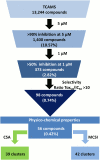A New Set of Chemical Starting Points with Plasmodium falciparum Transmission-Blocking Potential for Antimalarial Drug Discovery
- PMID: 26317851
- PMCID: PMC4552634
- DOI: 10.1371/journal.pone.0135139
A New Set of Chemical Starting Points with Plasmodium falciparum Transmission-Blocking Potential for Antimalarial Drug Discovery
Abstract
The discovery of new antimalarials with transmission blocking activity remains a key issue in efforts to control malaria and eventually eradicate the disease. Recently, high-throughput screening (HTS) assays have been successfully applied to Plasmodium falciparum asexual stages to screen millions of compounds, with the identification of thousands of new active molecules, some of which are already in clinical phases. The same approach has now been applied to identify compounds that are active against P. falciparum gametocytes, the parasite stage responsible for transmission. This study reports screening results for the Tres Cantos Antimalarial Set (TCAMS), of approximately 13,533 molecules, against P. falciparum stage V gametocytes. Secondary confirmation and cytotoxicity assays led to the identification of 98 selective molecules with dual activity against gametocytes and asexual stages. Hit compounds were chemically clustered and analyzed for appropriate physicochemical properties. The TCAMS chemical space around the prioritized hits was also studied. A selection of hit compounds was assessed ex vivo in the standard membrane feeding assay and demonstrated complete block in transmission. As a result of this effort, new chemical structures not connected to previously described antimalarials have been identified. This new set of compounds may serve as starting points for future drug discovery programs as well as tool compounds for identifying new modes of action involved in malaria transmission.
Conflict of interest statement
Figures








References
-
- World Health Organization. World Malaria Report 2014: WHO Press; 2014 [cited 2015 March]. Available: http://www.who.int/malaria/publications/world_malaria_report_2014/en/.
-
- Plouffe D, Brinker A, McNamara C, Henson K, Kato N, Kuhen K, et al. In silico activity profiling reveals the mechanism of action of antimalarials discovered in a high-throughput screen. Proceedings of the National Academy of Sciences of the United States of America. 2008;105(26):9059–64. 10.1073/pnas.0802982105 - DOI - PMC - PubMed
Publication types
MeSH terms
Substances
LinkOut - more resources
Full Text Sources
Other Literature Sources
Research Materials

